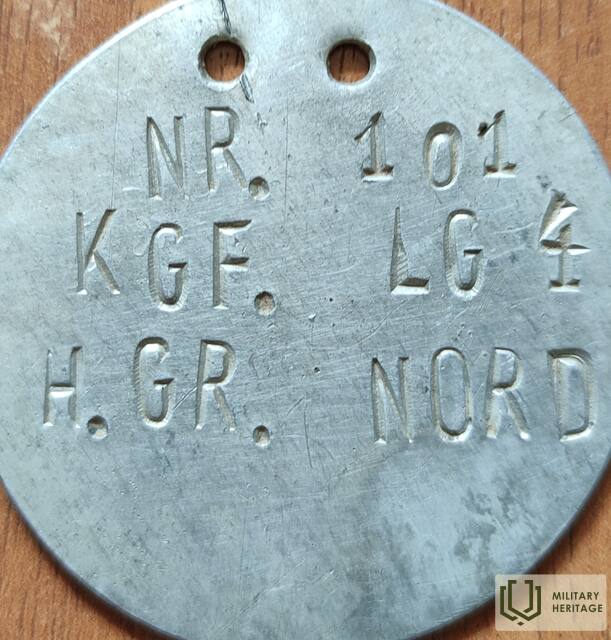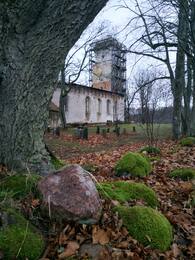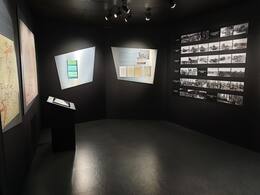Entdeckung des Filtrationslagers von Grieze
Auf dem Gelände des Filtrationslagers Grieze und an den Zufahrtsstraßen werden häufig verschiedene Gegenstände ehemaliger Soldaten gefunden. Soldaten, verhaftete Zivilisten, Kriegsgefangene usw. haben sie aus verschiedenen Gründen entsorgt, sowohl um nicht identifiziert zu werden als auch um zu vermeiden, dass ihnen "besondere Aufmerksamkeit" zuteil wird.
Erkennungsmarke eines Kriegsgefangenen, der im Kriegsgefangenenlager Nr. 4 der Heeresgruppe Nord der Bundeswehr inhaftiert war, wahrscheinlich zu Beginn des Deutsch-Sowjetischen Krieges ausgestellt. Es wurde auf dem Gelände des Lagers Grieze gefunden, wo auch ehemalige Rotarmisten der Filtration unterzogen wurden.
Nach der Kapitulation der Heeresgruppe Kurzeme entfielen auf die Leningrader Front der Roten Armee 284 171 Gefangene. 7493 waren Soldaten der Roten Armee, die aus deutscher Gefangenschaft entlassen wurden. 48 deutsche Generäle ergaben sich in die Gefangenschaft. Nach den Unterlagen, die bei der Kapitulation der Heeresgruppe Kurzeme vorgelegt wurden, belief sich die Zahl der Soldaten auf etwa 185 000. Der Rest der fast 100 000 Personen, die der Filtration unterworfen wurden, waren Kurzeme-Zivilisten und sowjetische Flüchtlinge, da die sowjetische Leningrader Front am 10. Mai 1945 anordnete, alle Männer zwischen 16 und 60 Jahren der Filtration zu unterwerfen.
Im Gegensatz zu den Streitkräften anderer Länder wurden in der Roten Armee die Kontrolle, die Bewachung, die Pflege und der Schutz der Kriegsgefangenen nicht von den Armeeeinheiten, sondern von den Organen für innere Angelegenheiten - dem Volkskommissariat für Staatssicherheit - durchgeführt. Die Hauptaufgabe der Filterung bestand darin, Bürger der UdSSR und der von der Sowjetunion besetzten Länder aufzuspüren, die auf deutscher Seite an den Feindseligkeiten teilgenommen hatten. Gefangene deutsche Soldaten wurden untersucht, um mögliche Kriegsverbrecher zu ermitteln.
In der Nähe der Kirche von Grieze befand sich vom 10. Mai bis zum 17. Juni 1945 ein Filtrationslager für Kriegsgefangene. Das Lager befand sich wahrscheinlich hier, weil die Kirche von Grieze in der Nähe der Hauptverkehrsstraßen lag. Die Gruben im Boden, in denen sich die Häftlinge in kalten Nächten vor der Kälte versteckten, indem sie sich mit allem Möglichen zudeckten, sind in der Umgebung noch gut zu erkennen. Während dieser Zeit verursachte die Rote Armee erhebliche Schäden im Inneren der Kirche (alle Kirchenbänke wurden entfernt - "für die Kriegsanstrengungen", die Kanzel wurde beschädigt, die Orgel wurde zerstört usw.). Im Kirchengebäude selbst wurde eine Wäscherei eingerichtet.
Dieses Exponat befindet sich heute in der Ausstellung über das Ende des Zweiten Weltkriegs im Zollhaus von Ezeres.
Zugehörige Zeitleiste
Zugehörige Objekte
Filtrationslager für Gefangene der Roten Armee in Grieze und die Kirche von Grieze
Grieze liegt an der lettisch-litauischen Grenze, wo der Fluss Vadakste in den Fluss Venta mündet. Die Kirche von Grieze wurde 1580 erbaut, aber die Gemeinde bestand schon vor 1567. Die Kirche wurde mehrmals umgebaut - 1769, 1845 und 1773 wurde die erste Orgel eingebaut. Sowohl das Altarbild als auch die beiden Glocken sind aus verschiedenen Gründen verloren gegangen.
Im Garten der Kirche befindet sich ein Friedhof, auf dem Angehörige der Kirche und Adelige begraben sind. Einer von ihnen ist der Griezer Organist Friedrich Baris und seine Frau Charlotte, denen ein Denkmal vor der Sakristei der Kirche gesetzt wurde. An der Südseite der Kirche sind 32 schwedische Soldaten begraben, die im Großen Nordischen Krieg gefallen sind. Auf dem Friedhof befinden sich auch die Gräber von 110 deutschen Soldaten, die im Ersten Weltkrieg gefallen sind und für die 1930 ein Denkmal errichtet wurde.
Während des Zweiten Weltkriegs wurde die Kirche in Mitleidenschaft gezogen, als Ende Oktober 1944 die Frontlinie entlang des Venta-Flusses verlängert wurde und die 225. deutsche Infanteriedivision in der Nähe der Kirche von Grieze stationiert war. Als die sowjetische 4. Stoßarmee am 19. November 1944 Angriffe über den Venta-Fluss startete, schlugen mehrere Artilleriegranaten in die Südwand der Kirche ein und der Kirchturm wurde schwer beschädigt.
Nach der Kapitulation der Heeresgruppe Kurzeme wurden an der Leningrader Front der Roten Armee 284 171 Menschen gefangen genommen. 7493 waren Soldaten der Roten Armee, die aus deutscher Gefangenschaft entlassen wurden. 48 deutsche Generäle ergaben sich in die Gefangenschaft. Nach den Unterlagen, die bei der Kapitulation der Heeresgruppe Kurzeme vorgelegt wurden, belief sich die Zahl der Soldaten auf etwa 185 000. Der Rest der fast 100 000 Personen, die der Filtration unterworfen wurden, waren Kurzeme-Zivilisten und sowjetische Flüchtlinge, da die sowjetische Leningrader Front am 10. Mai 1945 anordnete, alle Männer zwischen 16 und 60 Jahren der Filtration zu unterwerfen.
Im Gegensatz zu den Streitkräften anderer Länder wurden in der Roten Armee die Kontrolle, die Bewachung, die Pflege und der Schutz der Kriegsgefangenen nicht von den Armeeeinheiten, sondern von den Organen für innere Angelegenheiten - dem Volkskommissariat für Staatssicherheit - durchgeführt. Die Hauptaufgabe der Filterung bestand darin, Bürger der UdSSR und der von der Sowjetunion besetzten Länder aufzuspüren, die auf deutscher Seite an den Feindseligkeiten teilgenommen hatten. Gefangene deutsche Soldaten wurden untersucht, um mögliche Kriegsverbrecher zu ermitteln.
In der Nähe der Kirche von Grieze befand sich vom 10. Mai bis zum 17. Juni 1945 ein Filtrationslager für Kriegsgefangene. Das Lager befand sich wahrscheinlich hier, weil die Kirche von Grieze in der Nähe der Hauptverkehrsstraßen lag. Die Gruben im Boden, in denen sich die Häftlinge in kalten Nächten vor der Kälte versteckten, indem sie sich mit allem Möglichen zudeckten, sind in der Umgebung noch gut zu erkennen. Während dieser Zeit verursachte die Rote Armee erhebliche Schäden im Inneren der Kirche (alle Kirchenbänke wurden entfernt - "für den Kriegseinsatz", die Kanzel wurde beschädigt, die Orgel zerstört usw.). Im Kirchengebäude selbst wurde eine Wäscherei eingerichtet.
Der letzte Gottesdienst in der Kirche fand 1950 statt und die Gemeinde hörte auf zu existieren. Nach der Auflösung der Gemeinde, auch später unter der Aufsicht der lettischen Gesellschaft für Natur- und Denkmalschutz, wurde die Kirche nicht wieder instand gesetzt. Allerdings stand das Gebäude bis in die 1960er-1970er Jahre unter Dach. Die Kirche wurde während des Sturms von 1961 beschädigt, und 1968 wurden die verbliebenen Innenelemente von den Mitarbeitern des Rundāle-Palastes gerettet.
Seit 2003 ist eine Gruppe Gleichgesinnter aus Rigaer Kirchengemeinden an der Sanierung und Restaurierung der Kirche beteiligt. Bis heute wurden die Kirchenmauern konserviert und der Turm restauriert.
Zollhaus Ezere - Sammlung kulturhistorischer und heimatkundlicher Zeitzeugnisse
Das Zollhaus Ezere liegt unweit der Landstraße Saldus-Mažeikiai an der lettisch-litauischen Grenze. Am 8. Mai 1945 wurde in diesem Gebäude von den Befehlshabern der im Kurland-Kessel eingeschlossenen deutschen Heeresgruppe Kurland die Kapitulationsurkunde unterzeichnet. Daher kann man das Ende des Zweiten Weltkrieges in Ezere verorten. Die Ausstellung im alten Zollhaus informiert über die Ereignisse am Ende des Zweiten Weltkrieges sowie über die historische Entwicklung der Umgebung von Ezere von der Vor- und Frühgeschichte bis in unsere Tage. Am Morgen des 7. Mai 1945 stellte der Befehlshaber der Leningrader Front, Marschall L. Goworow, ein Ultimatum an die Befehlshaber der Heeresgruppe Kurland und forderte sie auf, die Waffen niederzulegen. Die Kapitulationsakte wurde am 8. Mai von beiden Seiten unterzeichnet und das weitere Vorgehen vereinbart: die Orte der Waffenübergabe, der Umfang der vorzulegenden Dokumente und Informationen sowie weitere Maßnahmen praktischer Natur.








